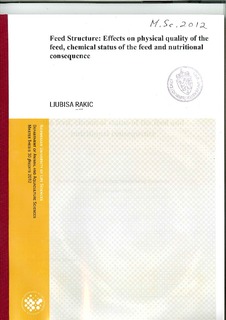Feed structure : effects on physical quality of the feed, chemical status of the feed and nutritional consequence
Master thesis
Permanent lenke
http://hdl.handle.net/11250/186115Utgivelsesdato
2013-10-21Metadata
Vis full innførselSamlinger
- Master's theses (IHA) [318]
Sammendrag
Two experiments were conducted to study effects of grinding and pelleting on feed structure using either wheat or maize as a base ingredients. In experiment 1, four diets were formulated to contain either completely ground base ingredients using 3 mm and 6 mm screen size in hammer mill or base ingredients were added as whole grain in ration of 30% whole grain 70% ground material. In addition base ingredients were mixed with mineral and vitamin premix to make complete diets. Smaller particles improved pellet durability but replacement of ground ingredients with whole ingredinets increased hardness. Coarse structure of the diets reduced energy consumption when compared with fine structured diets.
In experiment 2, pure wheat and barley were used as ingredients and were ground using either hammer mill fitted with 3 mm sieve or roller mill using 1.5 mm gap between rolls. In addition, a combination of the hammer mill fitted with 3 mm screen and roller mill with the 1.5 mm gap between rolls as a singular method was tested. Higher pellet durability and lower energy consumption was observed for wheat diets when compared to maize diets. Combination of the hammer mill + roller mill showed higher pellet durability for both cereal sources when compared with either hammer mill or roller mill alone.
Larger proportion of the particles smaller than 1.0 mm were found when diets were ground on a hammer mill fitted with 3 mm screen in comparison to hammer mill fitted with 6 mm screen (experiment 1) or roller mill with 1.5 mm roller gap (experiment 2). Roller mill had larger proportion of the particles over 1.6 mm in comparison to either combination of the hammer mill and roller mill or hammer mill alone (experiment 2).
